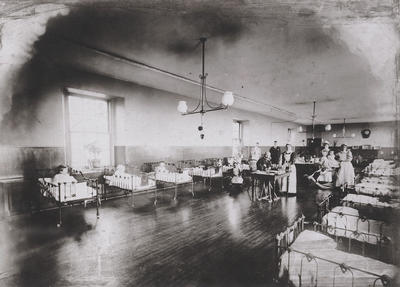
The children's ward at Barnhill Hospital c 1898. The four nurses and two doctors assembled for the picture (the Medical Officer Dr William Core is seated) would not represent everyday levels of staffing.
These children were sent from the adjacent Barony Parish Poorhouse (which became Barnhill Poorhouse in 1898, when the City and Barony parishes were amalgamated in the Parish of Glasgow), where conditions in the workhouse could be harsh. Barnhill Poorhouse had its own school, with one teacher to provide a basic education for children up to age 10 (for girls) or 12 (for boys). About a quarter of the children were orphans, the others being admitted to the poorhouse because their parents were unwilling or unable to look after them.
Subsequently, Barnhill adopted a policy of boarding out children, sending them to what would nowadays be described as foster parents. These people were usually residents of rural areas, where it was presumed the children would benefit from a healthier and more morally uplifting environment than in the city. By 1900 only infant children were boarded at Barnhill Poorhouse.
Reference: Glasgow City Archives, P9042
Reproduced with the permission of Glasgow City Council, Libraries Information and Learning
Keywords:
Barnhill Hospital, Barnhill Poorhouse, Barony Parish Poorhouse, beds, cots, disadvantaged children, doctors, foster parents, Glasgow Parish, hospitals, lady superintendents, matrons, medical officers, nurses, orphans, patients, physicians, poorhouse schools, poorhouses, primary education, rocking horses, wards, women, workhouses
You have 1 image in your photo album.